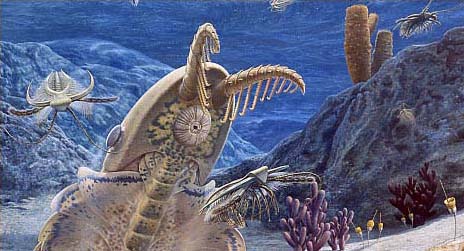 |
 |
 |
 |
 |
Produced
by the Population Genetics and Evolution class, Furman University |
||||
 |
 |
 |
 |
 |
Produced
by the Population Genetics and Evolution class, Furman University |
||||
 |
The
Cambrian: Protichnites |
 |
||
| Protichnites
are a type of ichnofossil, or "trace fossil" that have been
found in numerous sites across North America as early as the 1850s (MacNaughton
and Hagadorn 2006). These imprints originate from the Cambrian period,
usually comprising of a double row of tracks (Hecht 2009). The markings
are footprints that were preserved in sand and, through the sedimentation
process, eventually became sandstone (Hagadorn and Belt 2008). Ichnofossils
of Protichnites are particularly interesting in that the fossils
could have been made by one of the first terrestrial animals on Earth
(MacNaughton and Hagadorn 2006). This documented the important transition
animals made from ocean to land that occurred during the Cambrian period
(Hecht 2009). Evidence of odd markings that appear at regular intervals
in some fossils suggests that these arthropods carried shells with them,
possibly as a buffer against the terrestrial environment (Hecht 2009).
The shells would help retain moisture and avoid excessive ultraviolet
light (Hecht 2009). The behavior is similar to that of hermit crabs, butthe
prints suggest that Protichnites share a closer resemblance to
scorpions (Hecht 2009). Page by LinLin Zhao |
 |
| Protichnites ichnofossil. Photo Credit: J. W. Hagadorn, Amherst College | |
|
Hagadorn
J, Belt ES.2008. Stranded in upstate New York: Cambrian Scyphomedusae
from the Potsdam sandstone. Palaios. 23: 424-441. Hecht J. 2009. Early land visitors borrowed shells for protection. New Sci. 2703. MacNaughton RB, Hagadorn J. 2006. Paleontological Report. Commission Geologique du Canada. Accessed 1 February 2010. |